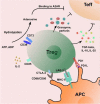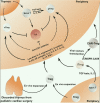Regulatory T cells in rheumatoid arthritis: functions, development, regulation, and therapeutic potential
- PMID: 36173485
- PMCID: PMC9522664
- DOI: 10.1007/s00018-022-04563-0
Regulatory T cells in rheumatoid arthritis: functions, development, regulation, and therapeutic potential
Abstract
Rheumatoid arthritis (RA) is an autoimmune disease that mainly affects the joints but also leads to systemic inflammation. Auto-reactivity and dysregulation of self-tolerance are thought to play a vital role in disease onset. In the pathogenesis of autoimmune diseases, disturbed immunosuppressive properties of regulatory T cells contribute to the dysregulation of immune homeostasis. In RA patients, the functions of Treg cells and their frequency are reduced. Therefore, focusing on the re-establishment of self-tolerance by increasing Treg cell frequencies and preventing a loss of function is a promising strategy for the treatment of RA. This approach could be especially beneficial for those patients who do not respond well to current therapies. In this review, we summarize and discuss the current knowledge about the function, differentiation and regulation of Treg cells in RA patients and in animal models of autoimmune arthritis. In addition, we highlight the therapeutic potential as well as the challenges of Treg cell targeting treatment strategies.
Keywords: Autoimmunity; CD4+ T cells; Chimeric antigen receptor; Regulatory T cells; Self-tolerance; Therapeutic potential.
© 2022. The Author(s).
Conflict of interest statement
The authors declare no competing interests.
Figures


Similar articles
-
Emerging therapeutic potential of regulatory T (Treg) cells for rheumatoid arthritis: New insights and challenges.Int Immunopharmacol. 2022 Jul;108:108858. doi: 10.1016/j.intimp.2022.108858. Epub 2022 May 19. Int Immunopharmacol. 2022. PMID: 35597122 Review.
-
Migration and homeostasis of regulatory T cells in rheumatoid arthritis.Front Immunol. 2022 Aug 9;13:947636. doi: 10.3389/fimmu.2022.947636. eCollection 2022. Front Immunol. 2022. PMID: 36016949 Free PMC article. Review.
-
Function and Role of Regulatory T Cells in Rheumatoid Arthritis.Front Immunol. 2021 Apr 1;12:626193. doi: 10.3389/fimmu.2021.626193. eCollection 2021. Front Immunol. 2021. PMID: 33868244 Free PMC article. Review.
-
Augmenting regulatory T cells: new therapeutic strategy for rheumatoid arthritis.Front Immunol. 2024 Jan 23;15:1312919. doi: 10.3389/fimmu.2024.1312919. eCollection 2024. Front Immunol. 2024. PMID: 38322264 Free PMC article. Review.
-
Review: Transcriptional Regulation of CD4+ T Cell Differentiation in Experimentally Induced Arthritis and Rheumatoid Arthritis.Arthritis Rheumatol. 2018 May;70(5):653-661. doi: 10.1002/art.40398. Epub 2018 Mar 13. Arthritis Rheumatol. 2018. PMID: 29245178 Free PMC article. Review.
Cited by
-
Microbiome's role in musculoskeletal health through the gut-bone axis insights.Gut Microbes. 2024 Jan-Dec;16(1):2410478. doi: 10.1080/19490976.2024.2410478. Epub 2024 Oct 10. Gut Microbes. 2024. PMID: 39387683 Free PMC article. Review.
-
Comprehensive investigation of network pharmacology, computational modeling, and pharmacokinetic assessment to evaluate the efficacy of flavonoids in rheumatoid arthritis.Mol Divers. 2024 Sep 30. doi: 10.1007/s11030-024-10989-4. Online ahead of print. Mol Divers. 2024. PMID: 39348084
-
Helper T Cells are Hyperactive and Contribute to the Dysregulation of Antibody Production in Patients with Rheumatoid Arthritis.Int J Mol Sci. 2024 Sep 23;25(18):10190. doi: 10.3390/ijms251810190. Int J Mol Sci. 2024. PMID: 39337675 Free PMC article.
-
Regulatory T lymphocytes as a treatment method for rheumatoid arthritis - Superiority of allogeneic to autologous cells.Heliyon. 2024 Aug 30;10(17):e36512. doi: 10.1016/j.heliyon.2024.e36512. eCollection 2024 Sep 15. Heliyon. 2024. PMID: 39319132 Free PMC article. Review.
-
Mesenchymal stem cell-derived extracellular vesicles in joint diseases: Therapeutic effects and underlying mechanisms.J Orthop Translat. 2024 Jul 27;48:53-69. doi: 10.1016/j.jot.2024.07.005. eCollection 2024 Sep. J Orthop Translat. 2024. PMID: 39170747 Free PMC article. Review.
References
-
- Smolen JS, Aletaha D, McInnes IB. Rheumatoid arthritis. Lancet. 2016;388(10055):2023–2038. - PubMed
-
- Cross M, et al. The global burden of rheumatoid arthritis: estimates from the global burden of disease 2010 study. Ann Rheum Dis. 2014;73(7):1316–1322. - PubMed
-
- Almutairi K, et al. The global prevalence of rheumatoid arthritis: a meta-analysis based on a systematic review. Rheumatol Int. 2021;41(5):863–877. - PubMed
-
- Helmick CG, et al. Estimates of the prevalence of arthritis and other rheumatic conditions in the United States. Part I Arthritis Rheum. 2008;58(1):15–25. - PubMed
Publication types
MeSH terms
LinkOut - more resources
Full Text Sources
Medical
Research Materials

